The curriculum provides a liberal arts education that includes science and physical education; being multifaceted, it also nurtures sensitivity and creativity.
Projects
Based on an abundance of themes, classes extend into various directions, including mathematics, social studies, languages, crafts and drawings.
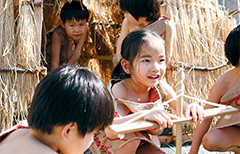
Kindergarten: The Jomon Era
Children learn about the way of life during the Jomon Era (14,000 BC to 300 BC). They use books and other resources to look into life during the Jomon Era and actually make pit dwellings, clothing, clay figures and “Jomon” cookies.” All this allows them to experience firsthand what life was actually like at that time.
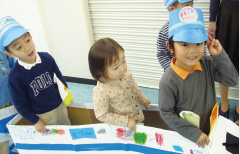
Pre-kindergarten: Trains
Under Dalton's commitment to the "city as a classroom," children visit train stations and observe the workings of ticket machines and signal stations. They engage in train play into which "passengers" are actually invited and develop other train-related activities.
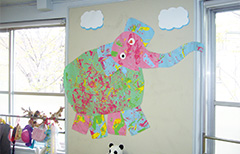
Nursery: Animals
After going on a field trip to the zoo, children look into the characteristics, food and other aspects of the animals; they also finger-paint large animals together. Individually, they expand their imaginations concerning what the animals are doing and enjoy making up stories about them.
Laboratory
In small groups in which one teacher is in charge of four or five children, flexible conceptual abilities and attitudes for undertaking tasks are fostered using original handmade educational materials.
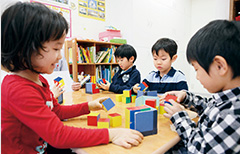
Kindergarten: Color and Dimension
Using four to eight blocks painted in four different colors, children try to assemble them so that the colors are arranged in the same way as the two-dimensional examples show.
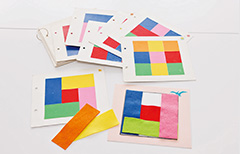
Pre-kindergarten: Layering Colored Paper
The children use four to six strips of colored paper and think about how to arrange them so that they are layered in the same way as the examples show.
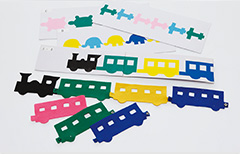
Nursery: Putting Together Trains
Children put together felt to make “trains” that match the colors of the trains presented on cards.
Free Play
Choosing what interests them from the variety of teaching tools available, children develop their own forms of play.
In areas set up in the corners of the room, children freely decide what they want to play. Options include different kinds of building-blocks, playing house, craft and arts, puzzles and games. Play expands children's interests and abilities, and they are encouraged by teachers who enable them to learn cooperation and social skills.
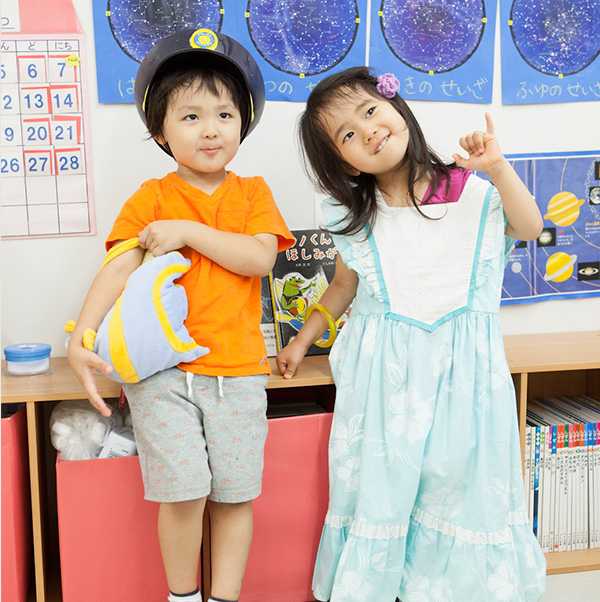
Garden Play
The children enjoy being physically active during garden play. The aim is also to have them improve their social skills and ability to cooperate.
They are free to enjoy slides, horizontal bars, climbing equipment, sand play or just to run around or play tag to their hearts' content. During this carefree time, they can chose whatever they want to play. In the summer, they also play with water.
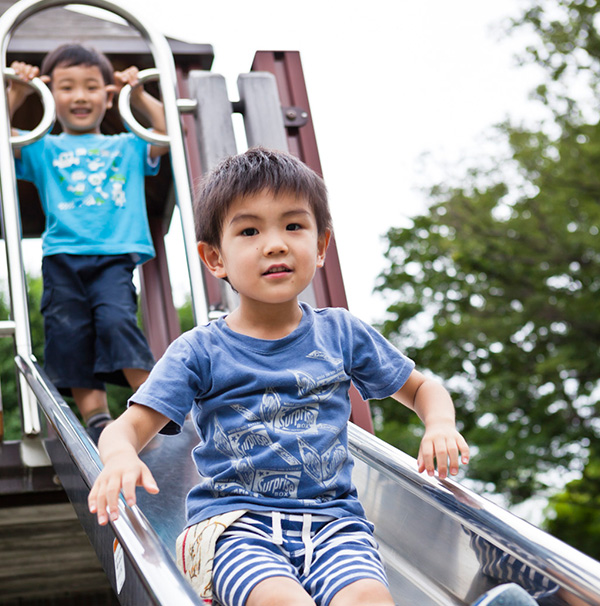
Special Subjects
Art
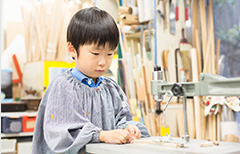
Using an abundance of materials, children engage in a wide range of activities, including drawing, playing with clay and woodworking.
They not only draw pictures but enjoy art while using an abundance of materials and techniques, such as working with stamps, wood, and marbling, making scratch drawings, and reproducing famous paintings.
Gymnastics
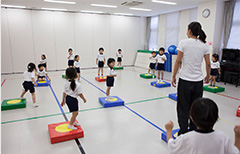
Strength, physical coordination, and sociability are enhanced.
Vaults, mats, climbing frames, horizontal bars, jump ropes, balls and the like are used to stimulate balanced physical development with play that is appropriate to children's stage of growth.
Music
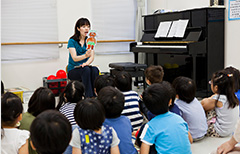
Through play and performance, children's enjoyment of music is nurtured.
With a wide range of musical activities, including singing, playing with instruments, and physical self-expression, children feel sounds and rhythms with the whole body. Use of a panel theater and listening to classical music help cultivate well-rounded sensitivities.
English
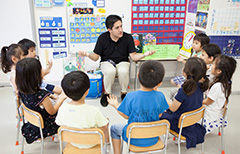
While relating with teachers who are native speakers, children have their sense of English and internationality fostered.
With picture books, songs, games, cards, and role play, children learn basic English conversation in kindergarten in small groups of about ten.
Science
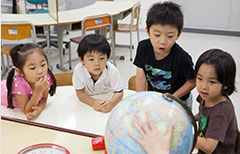
Why? How? With their sense of wonder as a starting point, children learn the joy of investigating and have their inquisitiveness nurtured.
Subjects familiar to them are taken up, such as excavating, creating planetariums, candle melting and hardening, and conducting experiments with flour, enabling them to experiment, observe and engineer.
Computers
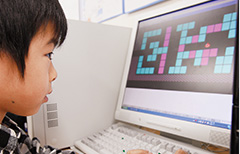
Through enjoyable activities involving graphics and thinking puzzles, children become familiar with the basic concepts for operating computers.
By creating works based on themes and through diagram-based learning to foster perceptions of direction and distance, children become used to operating the mouse and keyboard, thus learning the basics of (protocol for) computer literacy.
Work Time
Children come in contact with letters and numbers through play, heightening their abilities to understand and express.
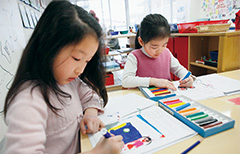
Kindergarten: A Book About Me
Children create books about themselves, such as the vegetables and animals they like, their fa milies, and what interests them.
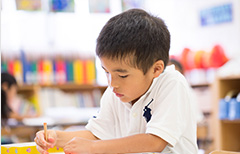
Pre-kindergarten: Initial Sounds, Ka and O
What words begin with ka? What words begin with o? Children immerse themselves into thinking of words and writing them down.
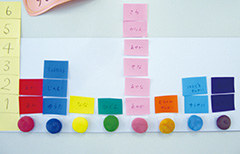
Nursery Graph: Votes for Favorite Colors
Children vote for the colors they like and make graphs. They read the numbers on the graphs to determine which colors are popular and discuss their findings together.
City as a Classroom
Children learn not only in the classroom but on their active outings into the city, during which they enjoy a variety of experiences.
They visit parks near the Dalton School, as well as stores, train stations, firehouses, shrines, and museums (art and other), and eldercare facilities. Understanding that the city is also their classroom expands their perspective.
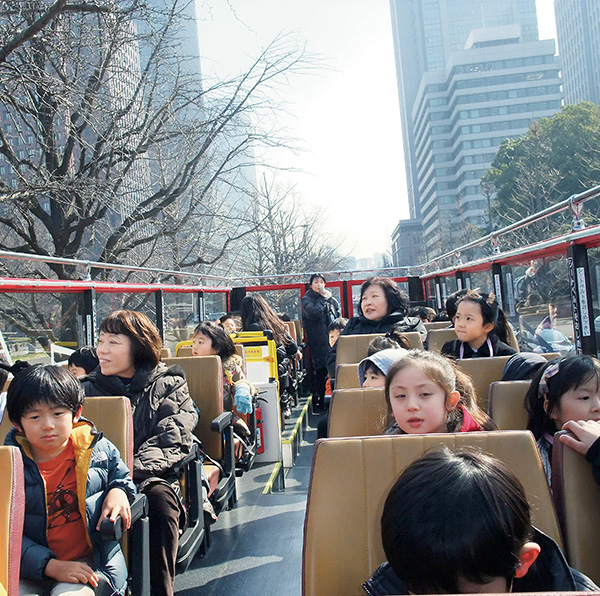
Serendipity Program
The Serendipity Program was established as part of after-school extended education, to be selected freely by those who wish to participate in the program. Examples of programs that have been conducted to the present are listed below. Content differs with the age group.
The word serendipity means the ability to discover the unexpected by chance. Through a highly varied program that includes academics, the arts, expression, sports, games, and exchanges with other age groups and through contact with highly individual teachers, children deepen their interest in and concern with various areas. This is the Serendipity Program, which incorporates the aim of having children discover their hidden abilities as its starting point.
 Science
Science Soccer and Ball games
Soccer and Ball games Rhythm and Dance
Rhythm and Dance
Science, Soccer and Ball games, English, Art, Music Adventure, Rhythm and Dance Hands-on, Computer, Cheerleading, Music














